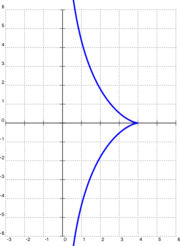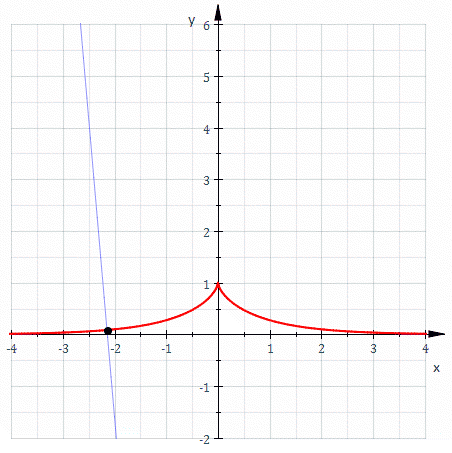Tractrix
A tractrix (from the Latin verb trahere "pull, drag"; plural: tractrices) is the curve along which an object moves, under the influence of friction, when pulled on a horizontal plane by a line segment attached to a tractor (pulling) point that moves at a right angle to the initial line between the object and the puller at an infinitesimal speed. It is therefore a curve of pursuit. It was first introduced by Claude Perrault in 1670, and later studied by Isaac Newton (1676) and Christiaan Huygens (1692).

Mathematical derivation
Suppose the object is placed at (a,0) (or (4,0) in the example shown at right), and the puller in the origin, so a is the length of the pulling thread (4 in the example at right). Then the puller starts to move along the y axis in the positive direction. At every moment, the thread will be tangent to the curve y = y(x) described by the object, so that it becomes completely determined by the movement of the puller. Mathematically, the movement will be described then by the differential equation
with the initial condition y(a) = 0 whose solution is
The first term of this solution can also be written
where arsech is the inverse hyperbolic secant function.
The negative branch denotes the case where the puller moves in the negative direction from the origin. Both branches belong to the tractrix, meeting at the cusp point (a,0).
Basis of the tractrix
The essential property of the tractrix is constancy of the distance between a point P on the curve and the intersection of the tangent line at P with the asymptote of the curve.
The tractrix might be regarded in a multitude of ways:
- It is the locus of the center of a hyperbolic spiral rolling (without skidding) on a straight line.
- The involute of the catenary function, which describes a fully flexible, inelastic, homogeneous string attached to two points that is subjected to a gravitational field. The catenary has the equation y(x) = a cosh x/a.
- The trajectory determined by the middle of the back axle of a car pulled by a rope at a constant speed and with a constant direction (initially perpendicular to the vehicle).

The function admits a horizontal asymptote. The curve is symmetrical with respect to the y-axis. The curvature radius is r = a cot x/y.
A great implication that the tractrix had was the study of the revolution surface of it around its asymptote: the pseudosphere. Studied by Eugenio Beltrami in 1868, as a surface of constant negative Gaussian curvature, the pseudosphere is a local model of non-Euclidean geometry. The idea was carried further by Kasner and Newman in their book Mathematics and the Imagination, where they show a toy train dragging a pocket watch to generate the tractrix.
Properties

- Due to the geometrical way it was defined, the tractrix has the property that the segment of its tangent, between the asymptote and the point of tangency, has constant length a.
- The arc length of one branch between x = x1 and x = x2 is a ln x1/x2.
- The area between the tractrix and its asymptote is πa2/2 which can be found using integration or Mamikon's theorem.
- The envelope of the normals of the tractrix (that is, the evolute of the tractrix) is the catenary (or chain curve) given by y = a cosh x/a.
- The surface of revolution created by revolving a tractrix about its asymptote is a pseudosphere.
Practical application
In 1927, P. G. A. H. Voigt patented a horn loudspeaker design based on the assumption that a wave front traveling through the horn is spherical of a constant radius. The idea is to minimize distortion caused by internal reflection of sound within the horn. The resulting shape is the surface of revolution of a tractrix.[1]
An important application is in the forming technology for sheet metal. In particular a tractrix profile is used for the corner of the die on which the sheet metal is bent during deep drawing.[2]
A toothed belt-pulley design provides improved efficiency for mechanical power transmission using a tractix catenary shape for its teeth.[3] This shape minimizes the friction of the belt teeth engaging the pulley, because the moving teeth engage and disengage with minimal sliding contact. Original timing belt designs used simpler trapezoidal or circular tooth shapes, which cause significant sliding and friction.
Drawing machines
- In October–November 1692, Christiaan Huygens described three tractrix-drawing machines.
- In 1693 Gottfried Wilhelm Leibniz devised a "universal tractional machine" which, in theory, could integrate any differential equation.[4] The concept was an analog computing mechanism implementing the tractional principle. The device was impractical to build with the technology of Leibniz's time, and was never realized.
- In 1706 John Perks built a tractional machine in order to realise the hyperbolic quadrature.[5]
- In 1729 Johann Poleni built a tractional device that enabled logarithmic functions to be drawn.[6]
A history of all these machines can be seen in an article by H. J. M. Bos[7]
See also
- Dini's surface
- Hyperbolic functions for tanh, sech, csch, arcosh
- Natural logarithm for ln
- Sign function for sgn
- Trigonometric function for sin, cos, tan, arccot, csc
Notes
- ↑ Horn loudspeaker design pp. 4–5. (Reprinted from Wireless World, March 1974)
- ↑ Lange, Kurt (1985). Handbook of Metal Forming. McGraw Hill Book Company. p. 20.43.
- ↑ "Gates Powergrip GT3 Drive Design Manual" (PDF). Gates Corporation. 2014. p. 177. Retrieved 17 November 2017.
The GT tooth profile is based on the tractix mathematical function. Engineering handbooks describe this function as a “frictionless” system. This early development by Schiele is described as an involute form of a catenary.
- ↑ Milici, Pietro (2014). Lolli, Gabriele, ed. From Logic to Practice: Italian Studies in the Philosophy of Mathematics. Springer.
... mechanical devices studied ... to solve particular differential equations ... We must recollect Leibniz's 'universal tractional machine'
|access-date=requires|url=(help) - ↑ Perks, John (1706). "The construction and properties of a new quadratrix to the hyperbola". Philosophical Transactions. 25: 2253–2262. JSTOR 102681.
- ↑ Poleni, John (1729). Epistolarum mathematicanim fasciculus. p. letter no. 7.
- ↑ Bos, H. J. M. (1989). "Recognition and Wonder – Huygens, Tractional Motion and Some Thoughts on the History of Mathematics" (PDF). Euclides. 63: 65–76.
References
- Kasner, Edward; Newman, James (1940). Mathematics and the Imagination. Simon & Schuster. p. 141–143.
- Lawrence, J. Dennis (1972). A Catalog of Special Plane Curves. Dover Publications. pp. 5, 199. ISBN 0-486-60288-5.
External links
| Wikimedia Commons has media related to Tractrix. |